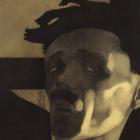Adolfo Wildt (1868-1931), Selfportrait, 1916, pencil and charcoal on paper mounted on cardboard, 640 x 640 mm signed and dated: "A.Wildt / MCMXVI" (inv. n. Agg. 426)
The drawing made in 1916 is a self-portrait, a form on which Wildt dwelt in crucial moments of his artistic life. As is the case of a marble self-portrait carved in 1909, the design of which is intimately related to this drawing, the subject takes on a kind of religious symbolism. In the work of 1909 the shape of the artist’s face clearly stands out from the slab on which are inscribed, in addition to the name and the date, three crosses indicating the three troubled years spent developing the image and the hardship of the creative process. The drawing of 1916 on the other hand, in addition to showing a more complete abandonment in the execution of the figure, suggesting almost a funeral portrait, sets the artist's head on an undefined background, the only intelligible elements of which are two crossed axes, easily interpreted as a cross, given the pose of the subject.
The drawing of the Civic Collections transmits an element of tragic Nordic expressivity, which harks back to the emotional charge of Gothic sculpture, through a translation of the figure into marble. This is evident from the modelling of the volumes of the face (with the highlights emphasising the quality of the stone) and typology of their simplification, as well as in the choice of leaving the eye sockets white beneath the lowered eyelids. The drawing alludes to a previous sculpted self-portrait and, more generally, to Gothic, Michelangelesque and Hellenistic sculpture. The sculpture of 1909 is instead empty, as shown by the absence of the eyes, and alludes to classical masks, in a game of models replicated in constantly varying materials and typologies, that are united by the delicate balance between a tragic expressivity and the algidity of the drawing.








